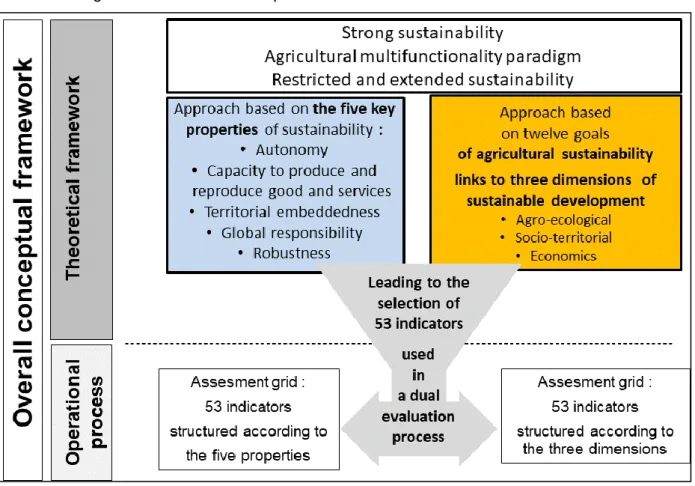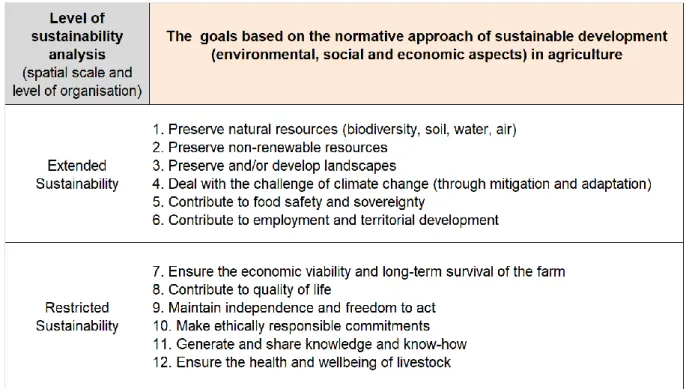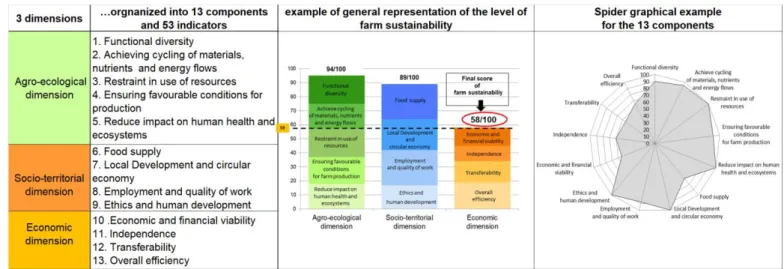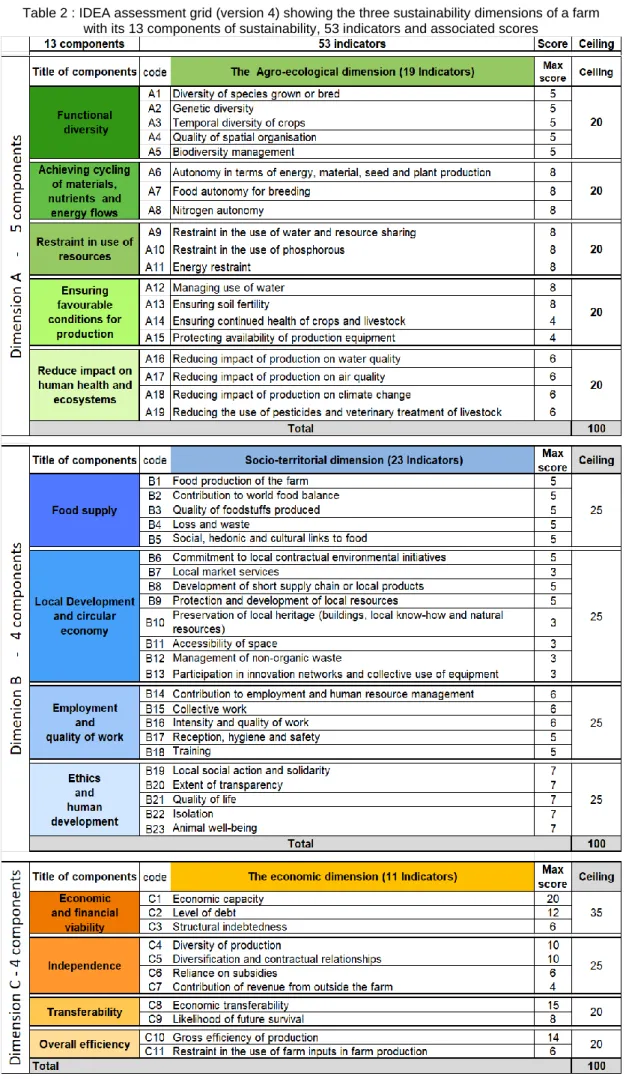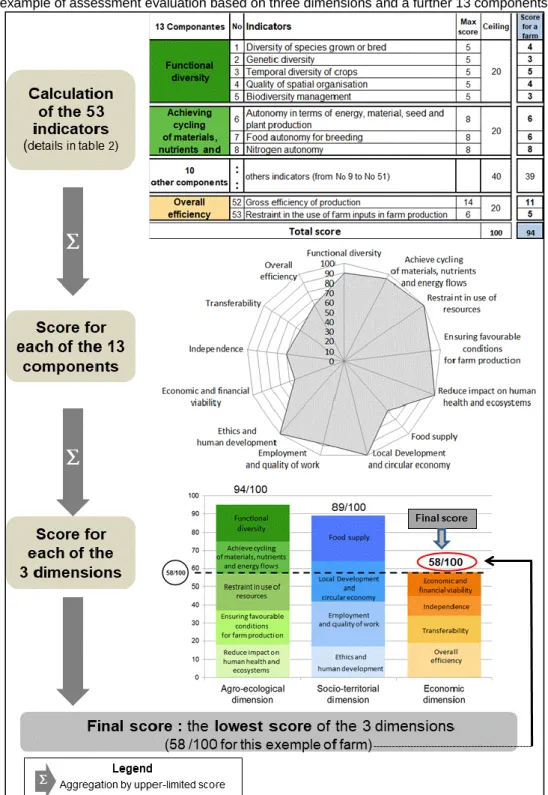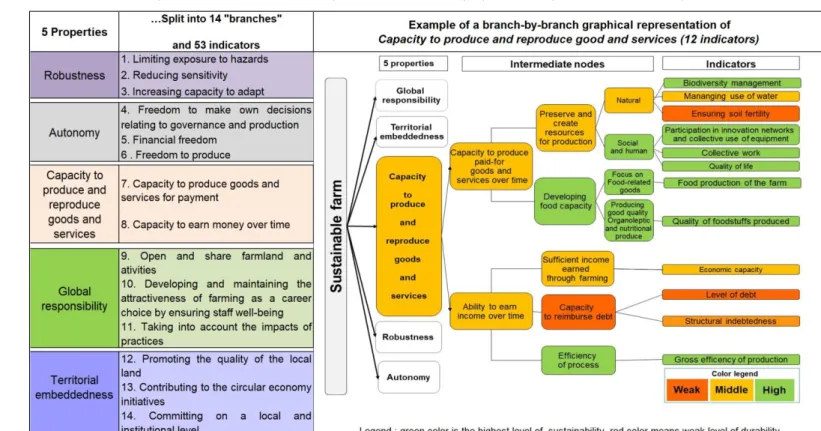HAL Id: hal-02737820
https://hal.inrae.fr/hal-02737820
Submitted on 2 Jun 2020HAL is a multi-disciplinary open access archive for the deposit and dissemination of sci-entific research documents, whether they are pub-lished or not. The documents may come from teaching and research institutions in France or abroad, or from public or private research centers.
L’archive ouverte pluridisciplinaire HAL, est destinée au dépôt et à la diffusion de documents scientifiques de niveau recherche, publiés ou non, émanant des établissements d’enseignement et de recherche français ou étrangers, des laboratoires publics ou privés.
Evaluating sustainability of farms: introducing a new
conceptual framework based on three dimensions and
five key properties relating to the sustainability of
agriculture. The IDEA method version 4
Frédéric Zahm, Adeline Ugaglia, Jean Marc Barbier, Héloïse Boureau,
Bernard Del’Homme, Mohamed Gafsi, Pierre Gasselin, Sydney Girard,
Laurence Guichard, Chantal Loyce, et al.
To cite this version:
Frédéric Zahm, Adeline Ugaglia, Jean Marc Barbier, Héloïse Boureau, Bernard Del’Homme, et al.. Evaluating sustainability of farms: introducing a new conceptual framework based on three dimensions and five key properties relating to the sustainability of agriculture. The IDEA method version 4. 13. European IFSA Symposium, International Farming Systems Association (IFSA). AUT., Jul 2018, Chania, Greece. �hal-02737820�
Theme 2 – Agroecology and new farming arrangements
13th European IFSA Symposium, 1-5 July 2018, Chania (Greece) 1
Evaluating sustainability of farms: introducing a new conceptual
framework based on three dimensions and five key properties relating to
the sustainability of agriculture. The IDEA method version 4
Frédéric Zahma*
,
Adeline Alonso Ugagliab, Jean-Marc Barbierc, Héloïse Boureaud; Bernard Del’hommee, Mohamed Gafsif, Pierre Gasselinc, Sydney Girarda, Laurence Guichardg, Chantal Loyceg, VincentMannevilleh, Amandine Meneti, Barbara Redlingshöferj
a* Corresponding and presenting author : frederic.zahm@irstea.fr Tel : +33 (5) 57 89 08 40 (a) Irstea, UR ETBX, 50 avenue de Verdun, F-33612 Gazinet Cestas, France
(b) UMR Save, Bordeaux Sciences Agro, 33170 Gradignan, France adeline.ugaglia@agro-bordeaux.fr (c) UMR Innovation, INRA, CIRAD, Montpellier SupAgro, Université Montpellier, France
jean-marc.barbier@supagro.inra.fr and pierre.gasselin@supagro.inra.fr
(d) Centre Ecodéveloppement de Villarceaux 95710 Chaussy, France heloise.boureau@bergerie-villarceaux.org (e) Bordeaux Sciences Agro, 33170 Gradignan, France bernard.delhomme@agro-bordeaux.fr
(f) UMR LISST - Dynamiques Rurales, CNRS, UT2J, EHESS, ENSFA, Toulouse, mohamed.gafsi@educagri.fr
(g) UMR Agronomie, AgroParisTech, INRA, Université Paris-Saclay, F-78850, Thiverval-Grignon, laurence.guichard@grignon.inra.fr et chantal.loyce@grignon.inra.fr
(h) Institut de l'élevage (IDELE), 9 allée Pierre de Fermat 63170, Aubière, France vincent.manneville@idele.fr (i) CEZ - Bergerie nationale de Rambouillet, France amandine.menet@educagri.fr
(j) INRA Agricultures urbaines / UMR SADAPT Paris, France - barbara.redlingshofer@inra.fr
Abstract :
This article shows how new theoretical work on assessing sustainability of farms, carried out as part of a multidisciplinary approach, allowed a new theoretical framework to be develop, along with version 4 of the IDEA Method (Indicateurs de Durabilité d’une
Exploitation Agricole). The first section divides existing studies taken from the literature into two types of indicator-based
conceptual frameworks: those based on sustainable agriculture goals, and those based on a systemic approach focusing on the properties of sustainability as applied to agriculture. The second part of this article explains the overall process of assessing farm sustainability based on the conceptual framework developed for IDEA v.4. The theoretical framework relates to strong sustainability and agricultural multifunctionality (with 12 associated goals). It includes a systemic analysis of sustainability based on five properties characterizing a sustainable farm: The ability to produce and reproduce goods and services; Autonomy; Robustness, Territorial embeddedness and Global responsibility. This theoretical framework led to the proposal of 53 indicators structured / organized according to a double evaluative approach (and also two assesment grids). The first examines the extent to which sustainability has been achieved (in agro-ecological, socio-territorial and economic terms) by aggregating indicators based on 13 components and a scoring system using sustainability “units”. The second approach assesses the level of sustainability based on the five properties mentioned above. Indicators are aggregated hierarchically. We discuss how the concept of properties has real educational value and can help to bring a new perspective to the field of sustainable farming.
Keywords: IDEA version 4, Sustainability assessment tools, Sustainable agriculture, Properties of sustainability, Farm
1.
Introduction
Recent states of the art looking at ways of assessing agricultural sustainability (Schader et al., 2014 ; Lairez et al., 2015 ; De Olde et al., 2016) have identified a whole plethora of different tools and methods, including a great variety of criteria and indicators. At the heart of this diversity are a number of vastly different conceptual frameworks. Establishing such a framework is, of course, a vital first step in any analysis of farming sustainability. A conceptual framework relating to farming sustainability has four main objectives: (1) to present the general objectives of the method in question; (2) to discuss the theoretical literature and underlying visions of the authors relating to sustainability (Hansen, 1996 ; Pope et al., 2004 ; López-Ridaura et al., 2002 ; Kates et al., 2005); (3) to characterise the farming system being studied (plot, cropping system, entire farm, region, country, etc.) and identify its relationships with other meta-systems (Smith et McDonald, 1998 ; López-Ridaura et al., 2005) and (4) to lay down the procedures to be used (the operationnel process and also interactions between disciplines, stakeholders’ participation, methods to select and aggregate indicators…). The IDEA method (Indicateurs de Durabilité d’une Exploitation Agricole or Farm Sustainability Indicators) is an indicator-based approach to analyze and assess the level of sustainability of a farm. First developed in the late 1990s, it has been updated on two occasions (Vilain et al., 2008; Zahm et al.; 2008). In this article, we present the latest conceptual framework developed based on work carried out by the IDEA Scientific Committee. The originality of this framework lies in the combined use of two theoretical approaches to analyse agricultural sustainability and to assess the sustainability of a farm.
The first part of the paper is a state of the art of the two possible theoretical approaches to assessing sustainability. The second part shows how the development of the IDEA v.4 conceptual framework has allowed the authors to make the following main advances based on this review of literature. Firstly it has been established a new theoretical framework based on five properties of sustainability (Ability to produce and reproduce goods and services; Autonomy; Robustness, Territorial embeddedness and Overall responsibility) and twelve goals (see table 1) taking into account also five new societal goals compared to IDEA version 3 (food, circular economy, climate change, air quality and low use of resources). Secondly, this new conceptual framework led to the proposal of 53 indicators structured / organized according to a double evaluative approach (and also two assesment grids): a first approach based on the three dimensions of sustainable development to assess the three agro-ecological, socio-territorial and economic dimensions of a sustainable farm, and second approach (new in this version) to qualify the degree of sustainability of a farm for each of the five properties. The third part of the paper highlights the possible uses and future developments of IDEA v.4 and explains the key theoretical contributions made by this research.
Theme 2 – Agroecology and new farming arrangements
13th European IFSA Symposium, 1-5 July 2018, Chania (Greece) 3
2. Two types of indicator-based approaches to assess agricultural sustainability
The following literature review identifies two indicator-based conceptual frameworks (Binder, 2010) to analyse agricultural sustainability. The first uses an goal-focused approach, while the second is based on key properties of sustainability.
2.1 An assessment approach based on agricultural sustainability goals
An objective-based, or “goal-oriented conceptual approach” (Von Wirén-Lehr, 2001) views agricultural sustainability as “the ability to satisfy a set of goals” (Hansen, 1996). In other words, sustainable agriculture is defined by the goals it aims to achieve (Kates et al., 2005). Viewing sustainability in this way is connected both to the societal issues faced by farmers and farming in general (global sustainability) and the internal goals which farmers aim to achieve (internal sustainability). This can be defined as the normative dimension of sustainability, or “a discussion of issues for which a consensus has been reached and a prioritisation of different actions needing to be taken” (Godard and Hubert, 2002). It points farmers in the right direction to achieve sustainability, based on pre-defined objectives (Sala et al., 2015). This approach depends on society’s values, and the perception of sustainability is framed by what society is aiming to achieve (Waheed et al., 2009).
The literature review leads to the following conclusions: 1) the term “goals” does not appear uniformly throughout the literature. It is often replaced by other terms such as “objective”, “issues”, “challenges”, “themes”, and “priorities”; 2) the term is based on a normative representation of sustainable development through its three official dimensions (environmental, social and economic), (UNCED, 1992). Such a normative approach of sustainable development was confirmed in 2015 by the United Nations with the adoption of the 2030 program for sustainable development. The program includes seventeen Sustainable Development Goals, including Goal 2 - "[...] Promoting Sustainable Agriculture" (UNO, 2015), which specifically addresses the goals of a sustainable agriculture.
2.2 An assessment approach based on properties of agricultural sustainability
The second approach to assessing agricultural sustainability focuses on properties (also referred to as “attributes” or “principles”). This “system-based framework” (Van Cauwenbergh et al., 2007) or System-based Property Oriented indicator Framework (SPOF) (Bockstaller et al., 2007), aims to create a set of indicators based on their ability to clearly identify the status of a system based on the properties of sustainability (Altieri, 1987 ; Conway, 1987 ; Smyth et Dumanski 1994 ; Bossel, 1999 ; López-Ridaura et al., 2005). For Hansen (1996) sustainability “interpreted as a property of agriculture has been developed in response to concerns about threats to agriculture, with the goal of using it as a criterion for guiding agriculture as it responds to change”.
Such an approach based on the qualification of sustainable development had already been proposed by Sachs (1980) in his work on ecodevelopment. He retained three of them: the notion of self-reliance the (autonomy of decisions and the emergence of alternative modes of development taking into account the historical contexts of each country), (ii) a fair management of the essential needs of each (material or
immaterial) and (iii) ecological prudence. This approach was also used in the MESMIS research program (López-Ridaura et al., 2002 ; Astier et al., 2011), which identified seven key properties to analyse rural agricultural sustainability in Latin America: productivity, stability, reliability, resilience, adaptability, equity and autonomy. Bossel (1999) uses a similar approach, referring to “fundamental properties” to define the “internal viability of the system being studied” and the “contribution made by the system to the performance of other systems”. He measures a system’s contribution to sustainable development by the presence of six properties: existence, effectiveness, freedom, security, adaptability and coexistence.
2.3 Comparative summary of the two approaches
The advantage of a goal-driven approach is that it facilitates communication between scientists and stakeholders (Sala et al., 2015). In this case, farmers and stakeholders who have to implement changes can easily pinpoint the real actions they need to take in order to achieve their particular goals (Alkan-Olsson et al., 2009). However, one of the downsides of this approach is that it can generate unnecessarily long lists of indicators if not combined with a systemic analysis of the farm being studied (Alkan-Olsson et al., 2009). There is also the risk that the choice of goals may be too subjective, because of the likelihood that those laying down the goals may allow themselves to be influenced by their own personal values (Hansen, 1996). It is more likely to appear in the case for the external sustainability.
Concerning the property-based approach, the advantage is that it remains generic and unaffected by the local context (Alkan-Olsson et al., 2009). That said, some authors, such as Bockstaller et al. (2007) have noted that such an approach can be awkward to use in practice, because it takes considerable time to explain it to people who are unfamiliar with such methods.
There is also a difference of point of views, goals-based framework include natively the ability to engage changes while property oriented approaches are more static.
3. Version 4 of the IDEA conceptual framework
IDEA version 4 method is an indicator-based sustainability assessment tool (Binder et al., 2010). It aims to evaluate the sustainability of a farm. It has been developed with two objectives in mind. The first objective is to be used as an educational and transparent tool to teach students in an operational way the concept of agricultural sustainability and farm sustainability. The second objective is to be used as a monitoring or decision support tool for farmers but also advisors to support the transition toward a more sustainable agriculture.
IDEA version 4 is based on the (overall) conceptual framework developed and presented on figure 1. This conceptual framework formalises both (i) the theoretical framework and (ii) the operational process of the IDEA version 4 method.
Theme 2 – Agroecology and new farming arrangements
13th European IFSA Symposium, 1-5 July 2018, Chania (Greece) 5
Figure 1: the overall conceptual framework of the method IDEA version 4
This figure 1 shows the structure of the conceptual framework following two steps. First a theoretical framework (presented in details in paragraph 3.1) was developed leading to the proposal of 53 indicators, and then an operational process structuring and organizing these 53 indicators into two evaluative assessment grids (see 3.2 and 3.3).
3.1 The theoretical framework
As the literature review shows, a conceptual framework based solely on normative goals of sustainability (as shown in IDEA version 3: Vilain et al., 2008 ; Zahm et al., 2008) is necessary to give first farmers but also all other stakeholders a clear sense of the goals to be achieved. While version 4 does not abandon this approach, it (the approach) does not allow a clear identification of the status of a system in terms of properties of sustainability. For this reason, IDEA v.4 also includes a property-based approach. The advantage is that it does not rely on societal goals, which depend on the local area they are embedded in. Selecting indicators from a theoretical assessment framework based on properties of agricultural sustainability has the advantage of not giving more weight and attention to the goals that would be contingent of the local scale (territory). This new approach adopted in Version 4 of IDEA method is therefore more generic than the IDEA method (version 3) which was based on a conceptual goals sustainability framework (Zahm et al., 2008).
In theoretical terms, the IDEA conceptual framework is one of strong sustainability: i.e. it does not subscribe to the principle that generated capital can ever compensate for the loss of natural capital (Daly, 1990). It is based on double vision of sustainable agriculture and sustainable farms as defined in box 1.
Box 1: Agricultural and farming sustainability concepts as employed in IDEA v.4
Sustainable agriculture is a form of agriculture that is economically viable, environmentally friendly, humane, and socially fair. It contributes both to the overall sustainability of the local area in which it is practised, and to the achievement of global sustainable development goals.
A sustainable farm is viable, acceptable, easily transmissible and readily reproducible. It is founded on a socially responsible approach. This approach depends on the choices made by farmers relating to the effects of their production methods on the quality of life of those living in the local area, as well as their contribution to realising global goals, such as fighting climate change, air quality, food safety, etc.
Source : Zahm et al., 2015
To qualify the sustainability of a farm, we defined five key properties (Zahm et al., 2015) based on the state of the art detailed above. The Capacity to produce and reproduce goods and services (property 1) refers to a farm’s long-term ability to efficiently produce and reproduce goods and services, without eroding the natural and social resources it possesses. Autonomy (property no. 2) covers a farm’s ability to produce goods and services from its own resources (inputs, human resources, and other production factors). It also includes its freedom to make decisions, its capacity to develop independently, and the extent of its dependence on public instruments (financial support, quotas, subsidies, etc). Robustness (property no. 3) is a farm’s ability to adapt to environmental, social, and economic fluctuations, and to deal with new conditions and/or disruption and external shocks. This property encompasses the concepts of resilience, adaptation, and flexibility. The Territorial embeddedness (property 4) means the ability of a farm to contribute to the co-production of local resources. It also highlights the nature and extent of market and non-market connections created with the local area, local residents, and stakeholders. Global responsibility (property no. 5) refers to the extent of a farm’s commitment to a global approach, taking into account the environmental and social consequences of their mode of operation. This commitment is grounded in values of ethics and equity. As with territorial influence, this property does not focus exclusively on the farm itself, but also examines the impact of its actions at higher levels of organisation.
The new conceptual framework also makes use of two concepts of sustainable agriculture. First, the restricted sustainability or farm-focused sustainability defined as being sustainable by and for itself through the use of sustainable practices. This restricted sustainability is “similar to the concept of durability which designates the capacity of the system to maintain itself but is economically and socially limited” (Terrier et al., 2013). Secondly, the extended sustainability aims to identify the societal goals of farms which also contribute to sustainable development at a larger scale (local, national and global) (Godard et Hubert, 2002; Terrier et al., 2013).
Twelve goals were selected on the basis of a literature review and also taking into account the goals set in the IDEA version 3 method but enriched by new societal goals (food safety and sovereignty, territorial development in relation with circular economy, climate change, air quality and low use of resources) within this version 4. These twelve goals may be divided according to these two sustainability levels of
Theme 2 – Agroecology and new farming arrangements
13th European IFSA Symposium, 1-5 July 2018, Chania (Greece) 7
sustainability analysis (extended and restricted sustainability), as shown in the table 1. The six goals refering mainly to local and global environment of the farm are assigned to extended sustainability (1. Preserve natural resources (biodiversity, soil, water, air); 2. Preserve non-renewable resources: 3. Preserve and/or develop landscapes ; 4. Deal with the challenge of climate change (through mitigation and adaptation); 5. Contribute to food safety and sovereignty ; 6. Contribute to employment and territorial development). The six goals referring mainly to the farm level (including the farmer, his family and employees) are grouped into restricted sustainability (7. Ensure the economic viability and long-term survival of the farm ; 8. Contribute to quality of life ; 9. Maintain independence and freedom to act ; 10. Make ethically responsible commitments; 11. Generate and share knowledge and know-how ; 12. Ensure the health and wellbeing of livestock).
Table 1 : the twelve goals relative to their level of sustainability for a farm
3.2 Operational process
The operation application of the IDEA v.4 conceptual framework is founded on three key elements. The first is the definition and creation of indicators based on three principles: (i) compatibility with the relevant theoretical framework, (ii) ensuring good quality indicators, based on recognised standards (Reeds et al., 2006) (relevance, principle of parsimony, sound scientific grounding, fair assessment, measurability, educational value, transparency, and ease of interpretation based on benchmark thresholds), and (iii) ease of use for farmers, advisors, and students. The second element is the creation of a heuristic chart based on the five key properties of sustainability (Figure 2), leading to the design of 53 indicators. The third and final part of the operational process is the construction of two complementary grids of assessment, as shown below (figures 3 and 4). These two assessments use the same 53 indicators in two ways: one assessment grid organized according to the five properties of sustainability, and another one based on a normative approach relative to the three dimensions of sustainable agriculture.
Theme 2 – Agroecology and new farming arrangements
9 3.3 The evaluation structured according to the three key dimensions of agricultural sustainability This approach involves organising the selected 53 indicators in such a way as to display a level of sustainability based on the three normative dimensions of sustainable development: agro-ecology, socio-territorial aspects and economics. These are organised into thirteen components as shown in figures 3 and 4. A component groups all the indicators that describe a same theme in its plurality.
The agroecological dimension is structured around five components: 1 - Functional diversity, 2 - Achieving cycling of materials, 3 - Nutrients and energy flows, 4 - Restraint in use of resources and ensuring favourable conditions for production, 5 - Reduce impact on human health and ecosystems). The socioterritorial dimension contains four components (6. Food supply, 7. Local Development and circular economy, 8. Employment and quality of work and 9. Ethics and human development). The economic dimension is characterized thanks to four components (10 - Economic and financial viability, 11 - Independence, 12 - Transferability and 13. Overall efficiency).
Figure 3 : First grid assessment based on three sustainability dimensions
The main calculation rules can be described as follows.
The higher the score (between 0 and 100), the more sustainable the farm is. There is a final sustainability score for each of the three dimensions (see example in figures 3 and 4) with an equal weight between the 3 dimensions (see table 2). The final sustainability level of the farm is the lowest score out of all three dimensions, bearing in mind that the method is based on the principle of “strong” sustainability (e.g. a score of 58/100 for example for a farm, see Figure 3).
Within each dimension, indicators are aggregated by component. These components each have three functions: (1) theme-based organisation of the 53 selected indicators (table 2), (2) weighting each component within each dimension, and (3) compensating sustainability of the indicators contained within one component. The dimension score is the cumulative number of basic sustainability units for the different indicators in the scale after weighting and aggregating the individual indicator scores within each component. Each dimension scale goes from 0 to 100 units of sustainability (table 2) and there is a ceiling value of units for each component (between 20 units to 35 units depending the different components). This
Theme 2 – Agroecology and new farming arrangements scores (or units) system is based with an upper limit for each indicator. Maximum scores are set for each indicator in order to set an upper limit on the total number of sustainability units for each component and dimension (100 units). The maximum score awarded to each indicator is defined not with the aim of establishing an absolute optimal value, but rather practices, behaviour or levels of results that do not give rise to fundamental problems concerning the notion of sustainability for the component. The sum of the durability units of the indicators within each component is higher than the ceiling value of the component.
This limitation weights the relative weight of the number of indicators per component and allows a large number of combinations to reach the maximum level of durability of the component. This cap system is established to avoid the process of offsetting or overweighting one or more indicators.
Theme 2 – Agroecology and new farming arrangements
11
Table 2 : IDEA assessment grid (version 4) showing the three sustainability dimensions of a farm with its 13 components of sustainability, 53 indicators and associated scores
Theme 2 – Agroecology and new farming arrangements From experience following the many tests (more than 3000 farms) of use of the three previous versions of the IDEA method (Zahm et al., 2008, Vilain et al., 2008; Rousselet, 2011) by applying a such system of ceiling to each component, the sustainability of many different farms can be assessed, taking into account the fact that they cannot all be covered by a single socio-technical model. Because of the vast range of local contexts and production systems in which farms operate, each will use a different combination of actions and take its own path to achieving sustainability. By displaying the information in this way, farmers can see areas where there is still progress to be made. An example of this aggregation process is shown in figure 4 below. It concerns a farm with a score of 94 sustainability units for the agroecological dimension, 89 units for the socio-territorial dimension and 58 units for the economic dimension.
Theme 2 – Agroecology and new farming arrangements
13 3.4 The evaluation structured according to the five key properties of sustainability
In this approach, the fifty-three indicators are structured around our five key properties (Capacity to produce and reproduce goods and services, Autonomy, Robustness, Territorial embeddedness and Global responsibility), which are themselves divided up into fourteen different branches (from limiting exposure to hazards to Committing on a local and institutional level, see Figure 5). One of the key strategic choices made was not to aggregate the scores of each of the five properties into an overall sustainability score. They are aggregated only within each property. The reason why they are aggregated in this way is that a more “overall” style of aggregation does not adequately identify potential actions to be taken for each individual property. By looking at them individually, it is possible to work with farmers to improve the areas of their operation identified as being the least sustainable. The second methodological choice was to include an ascending system of aggregation, working up through the different intermediate nodes of the 14 branches making up each property, as show in Figures 2 and 5).
The third strategic choice was to use hierarchical qualitative aggregation, making use of the DEXi multi-criteria decision application (Bohanec et al., 2008). This application assigns qualitative classes of sustainability (e.g. low, medium, high) to each indicator. After the aggregation process based on utility functions, results are displayed for all the nodes, as shown in the diagram in figure 5.
Figure 5 : Second assessment grid based on the five properties of agricultural sustainability
Figure 5 shows the property Capacity to produce and reproduce goods and services initially evaluated based on twelve indicators: (1) Biodiversity management, (2) Managing use of water, (3) Ensuring soil fertility, (4) Participation in innovation networks and collective use of equipment, (5) Collective work, (6)
Theme 2 – Agroecology and new farming arrangements Quality of live, (7) Food production of the farm, (8) Quality of foodstuffs produced, (9) Economic capacity, (10) Level of debt, (11) Structural Indebtedness and (12) Gross efficiency of production.
These twelve indicators are then aggregated according to the “sub-branches” of each category to evaluate the extent to which that category has been achieved (the capacity to produce and reproduce goods and services in this case).
4. Discussion
The new IDEA v.4 conceptual framework was developed based on the following objectives: (1) ensuring it remained a useful teaching aid while introducing a new theoretical approach based on properties of sustainability, (ii) maintaining its scientific credibility by including new scientific knowledge gained since the last version 3, (iii) maintaining the key operational features recognised by the existing user base. A number of new societal issues have also been included: food, the circular economy, climate change, air quality, and restraint (low) in use of resources.
Finally, these two assessment grids are complementary. There is no hierarchy between them. Each shows in a different way the concept of a sustainable farm. While the two complementary approaches used in the IDEA v.4 have now been finalised, both in terms of the conceptual framework and their indicators (components/dimensions and branches/properties), there is still work to be done on their practical application.
For the three-dimension approach, the assessment grids have now been completed (see table 2 and appendice 1), and a working system has been developed to automatically input data and generate the two diagrams, as shown in Figures 3 and 4. This works through Microsoft Excel. A number of modifications and improvements were made to this approach following a trial period from 2015 to 2017, where 61 farming systems were studied, ranging from livestock breeding and crop-livestock, to arable crops (used for the dimensions) and viticulture (used specifically for the economic dimension). These sites are characterised by very different soil and climate types (Nouvelle Aquitaine, Brittany, Midi-Pyrénées, and Rhône-Alpes) and varied collective and individual dynamics. First tests show that IDEA version can be used as a self-assessment diagnosis tool directly by farmers.
For the five-property approach, the decision rules for aggregating the indicators will be finalised as part of the ACTION research program (CASDAR 2017-2021) and will make use of the contingency matrix contained within the DEXi application.
Our first operational tests have shown that the “properties” and “dimensions” methods complement each other well when used together, providing a clear training tool to teach agricultural sustainability, as well as a fast and efficient way to display the overall sustainability of a farm (via qualitative analysis of the property branches) without having to collect all data from each indicator.
The next key task will be to finalise a clear, operational aggregation table. It would also be interesting to look at whether this generic analytical framework could be applied to farming systems outside of Europe. It
Theme 2 – Agroecology and new farming arrangements
15 would also be interesting to examine possible uses of IDEA v.4 within the process of advising agro-ecological transition.
5. Conclusion
This new conceptual framework makes the following contributions to the field: (i) an explanation of the notion of “properties” within a farming system and an integrated understanding of the complexities of such systems, as suggested by Lopez-Ridaura et al.(2002), (ii) a reference for a transparent normative evaluation system for farms, based on twelve objectives divided up according to their relevant theoretical frameworks (extended and restricted sustainability) and (iii) a way of evaluating a farm’s sustainability through two modes of interpretation: the first through the three dimensions of sustainable development, and the second through the properties attributed to a sustainable farming system.
The next research goals will be to work with stakeholders to examine the extent to which IDEA’s twin dimension/property can be used to support agro-ecological transition for farmers and advisers, particularly in identifying levers for actions. The French CASDAR ACTION research project will look specifically at these issues.
Theme 2 – Agroecology and new farming arrangements References
Altieri, M.A. (1987). Agroecology: the scientific basis of alternative agriculture. Westview Press Boulder Colorado. L'agroécologie: bases scientifiques d'une agriculture alternative, Paris: Ed. Debard.
Alkan-Olsson, J., Bockstaller, C., Stapleton, L., Ewert, F., Knapen, R., Therond, O., Geniaux, G., Bellon, S., Pinto-Correira, T., Turpin, N., Bezlepkina, I. (2009) A goal oriented indicator framework to support integrated assessment of new policies for agri-environmental systems. Environmental science & policy 12: 562-572. Astier, M., Speelman, E.N., López-Ridaura S., Masera O.R., Gonzalez-Esquivel C.E., (2011) Sustainability
indicators, alternative strategies and trade-offs in peasant agroecosystems: analysing 15 case studies from Latin America. International Journal of Agricultural Sustainability 9 (3): 409-422.
Bohanec, M., Messéan, A., Scatasta, S., Angevin F., Griffiths, B., Krogh, P.H., Znidarsicn M., Dzeroskin S. (2008) A qualitative multi-attribute model for economic and ecological assessment of genetically modified crops. Ecological Modeling 215: 247-261.
Binder, C.R., Feola, G., Steinberger, J.K. (2010) Considering the normative, systemic and procedural dimensions in indicator-based sustainability assessments in agriculture. Environmental Impact Assessment Review 30: 71-81.
Bockstaller, C., Bellon, S., Brouwer, F., Geniaux, G., Pinto-Correira, T., Stapleton, L.M., Alkan-Olsson, J. (2007) Developing an indicator framework to assess sustainability of farming systems. Farming Systems Design, pp. 141-142.
Bockstaller, C., Bellon, S., Brouwer, F., Geniaux, G., Girardin, P., Pinto-Correira, T., Stapleton, L.M., Alkan-Olsson, J. (2007). Developing an indicator framework to assess sustainability of farming systems. In: Donatelli M., Hatfield J., Rizzoli A. (eds.), Int. symposium on methodologies for integrated analysis of farm production systems. Catania, 10-12 September 2007, pp. 141-142.
Bossel, H. (1999) Indicators for sustainable development: theory, method, applications. Report to the Balaton group, International Institute for Sustainable Development, Winnipeg, pp. 118.
Chia, E., Rey-Valette, H., Lazard, J., Clément, O., Mathé, S. (2009) Évaluer la durabilité des systèmes et des territoires aquacoles: proposition méthodologique. Cahiers Agricultures 18 (2-3): 211-219.
Conway, G.R. (1987) The Properties of Agroecosystems. Agricultural Systems 24: 95-117.
Daly, H.E. (1990) Towards some operational Principles of Sustainable Development. Ecological Economics 2: 1-6. De Olde, E.M., Oudshoorn, F.W., Sørensen, C.A., Bokkers, E.A., De Boer, I.J. (2016) Assessing sustainability at
farm-level: Lessons learned from a comparison of tools in practice. Ecological Indicators 66: 391-404
Godard, O. and B. Hubert (2002) Le développement durable et la recherche scientifique à l’INRA. Rapport intermédiaire de mission, Paris: Inra éditions, pp. 58.
Hansen, J.W. (1996) Is agricultural sustainability a useful concept? Agricultural Systems 50: 117-143
Kates, R.W., Parris, T.M., Leiserowitz, A.A. (2005) What is sustainable development. Environment: Science and Policy for Sustainable Development 47(3): 8-21.
Koohafkan, P., Altieri, M.A., Gimenez, E.H. (2011) Green Agriculture: foundations for biodiverse, resilient and productive agricultural systems. International Journal of Agricultural Sustainability DOI:10.1080/14735903.2011.610206.
Lairez, J., Feschet, P., Aubin, J., Bockstaller, C., Bouvarel, I. (2015) Évaluer la durabilité en agriculture. Guide pour l’analyse multicritère des productions animales et végétales, Versailles : éditions Quae et Dijon : éditions Éducagri.
López-Ridaura, S., Masera, O., Astier, M. (2002) Evaluating the sustainability of complex socioenvironmental systems. The MESMIS framework. Ecological Indicators 2: 135-148.
López-Ridaura, S., Van Keulen, H., Van Ittersum, MK., Leffelaar, PA. (2005) Multiscale methodological framework to derive criteria and indicators for sustainability evaluation of peasant natural resource management systems. Environment, Development and Sustainability 7: 51-69.
Meul, M., Van Passel, S., Nevens, F., Dessein, J., Rogge, E., Mulier, A., Van Hauwermeiren, A. (2008) MOTIFS: a monitoring tool for integrated farm sustainability. Agronomy for Sustainable Development 28: 321-332.
Theme 2 – Agroecology and new farming arrangements
17
ONU. (2015) Transformer notre monde: le Programme de développement durable à l’horizon 2030. Rapport A/RES/70/1, New York.
Pope, J., Annandale, D., Morrison-Saunders, A. (2004) Conceptualising sustainability assessment. Environmental Impact Assessment Review 24(6): 595-616.
Reed, M.S., Fraser, E.D., Dougill, A.J. (2006) An adaptive learning process for developing and applying sustainability indicators with local communities. Ecological economics 59(4): 406-418.
Rousselet A., 2011, Durabilité des exploitations agricoles et méthode IDEA. Analyse de l’utilisation et de la perception de la méthode, Mémoire d'ingénieur AgroSup Dijon sous la direction de F. Zahm et L. Guichard Sachs I., 1980, Stratégies de l'écodéveloppement, Paris, Editions Économie et Humanisme et les Editions Ouvrières, Sala, S., Ciuffo, B., Nijkamp, P. (2015) A systemic framework for sustainability assessment. Ecological Economics
119: 314-325.
Schader, C., Grenz, J., Meier, M.S., Stolze, M. (2014) Scope and precision of sustainability assessment approaches to food systems. Ecology and Society 19(3): 42.
Smith, C.S., McDonald G.T. (1998) Assessing the sustainability of agriculture at the planning stage. Journal of Environmental Management 52: 15-37.
Smyth, A.J., Dumanski J. (1994) FESLM: An International Framework for Evaluating Sustainable Land Management. World Soil Resources Report No. 73, Rome, FAO.
Terrier, M., Gasselin P., Le Blanc, J. (2013) Assessing the sustainability of activity systems to support households’ farming projects. In: Auteur (ed), Methods and Procedures for Building Sustainable Farming Systems: Application in the European Context. Springer Netherlands pp. 47-61.
UNCED. (1992) Agenda 21 – an action plan for the next century. Endorsed at the United Nations Conference on Environment and Development, New York.
Vilain, L., Boisset, K., Girardin, P., Guillaumin, A., Mouchet, C., Viaux, P., Zahm, F. (2008) La méthode IDEA Indicateurs de durabilité des exploitations agricoles, 3ème édition, Dijon : Ed. Educagri, 184 p..
Van Cauwenbergh, N., Biala, K., Bielders, C., Brouckaert, V., Franchois L., Garcia Cidad, V, Hermy M, Mathijs E, Muys B, Reijnders J, Sauvenier X, Valckx J, Vanclooster M, Van Der Veken B, Wauters E, Peeters A. (2007). SAFE-A hierarchical framework for assessing the sustainability of agricultural systems. Agriculture, Ecosystems & Environment 120(2-4): 229-242.
Von Wirén-Lehr, S. (2001) Sustainability in agriculture- an evaluation of principal goal-oriented concepts to close the gap between theory and practice. Agriculture, Ecosystems & Environment 84(2): 115-129.
Waheed, B., Khan, F., Veitch, B. (2009) Linkage-based frameworks for sustainability assessment: making a case for driving force-pressure-state-exposure-effect-action (DPSEEA) frameworks. In Sustainability 1(3): 441-463. Zahm, F., Viaux, P., Vilain, L., Girardin, P., Mouchet, C. (2008) Farm Sustainability Assessment using the IDEA
Method. From the concept of farm sustainability to case studies on French farms. Sustainable Development 16: 271-281.
Zahm, F., Alonso Ugaglia, A., Boureau, H., Del’homme, B., Barbier, J.M., Gasselin, P., Gafsi, M., Guichard, L., Loyce, C., Manneville, V., Menet, A., Redlingshofer, B., (2015) Agriculture et exploitation agricole durables : état de l’art et proposition de définitions revisitées à l’aune des valeurs, des propriétés et des frontières de la durabilité en agriculture. Innovations Agronomiques 46 : 105-125.
Theme 2 – Agroecology and new farming arrangements
Appendice 1 : Four examples of indicator calculation
Example of calculation for an indicator of Agro-ecological dimension (A)
The indicator A 18 : Reducing impact of production on climate change
Indicator title
How to calculate scores
Max value for the score Reducing impact of production on climate change
Calculation 1 : Calculated value of gross emissions (in Tonnes of CO2
equivalent) (see the calculation table to convert energy inputs and emissions of
CH4, N2O by animals and fertilizers)
Calculation 2 : Calculated value of carbon sequestration / compensation (permanent pasture, temporary pasture, agroforestry)
(Tonnes of CO2 equivalent)
Net carbon emissions for the farm (in Tonnes of CO2 equivalent)
= calculation 1 – calculation 2
= Gross emissions – carbon sequestration and compensation Different classes and thresholds score value
< 200 T CO2 equivalent: ……. 6 units max
Between 200 and 400 : … 5units (*) Between 400 and 600 :…… .4 units Between 600 and 800 :……. 3 units Between 800 and 1000 :….. 2 units Between 1000 and 1200 : … 1 units >1200 T CO2 equivalent: …… 0 unit
6
Goals
1. Preserve natural resources (biodiversity, soil, water, air)
4. Deal with the challenge of climate change (through mitigation and adaptation) 8. Contribute to quality of life
10. Make ethically responsible commitments
Properties Global responsibility
Legend: (*) A farm has a score of 5 units means its net emissions are between 200 and 400 Tonnes CO2 equivalent
One example of calculation for an indicator of Economic dimension (dimension C)
The indicator C2 : Level of debtIndicator title
How to calculate scores
Max value for the score Level of debt (L o D) LoD=
Annuity amount loan (Long and medium term) + financial costs (short term)
Gross Operating Profit
- LoD < 30 % ……..… 12 units max - 30 ≤ LoD < 45 % ….. 8 units - 45 ≤ LoD < 60 % ….. 4 units - LoD ≥ à 60 % ……… 0 unit
12
Goals 7. Ensure the economic viability and long-term survival of the farm 9. Maintain independence and freedom to act
Theme 2 – Agroecology and new farming arrangements
19
Examples of calculation for two indicators of Socio-territorial dimension (B)
The indicator B 8 : Development of short supply chain or local products Indicatortitle
How to calculate scores
Max value for the score Development of short supply chain or local products
Item 1: Development of direct selling or short supply chains 2 units max No direct selling or no Short Supply Chains 0
Direct selling or short supply chains < 5% of the turnover: 0 Direct selling or short supply chains < 50 % of the turnover: 1 Direct selling or short supply chains > 50 % of the turnover: 2
Item 2: Development of geographic proximity……….3 units max Proximity sale to the final consumer or local food network:
‐ In a collective way …... 3 units ‐ Individual way ………2 units
Item 3: To contract with local canteens or local catering or local public markets………… ……….3 units max
5
Goals
5. Contribute to food safety and sovereignty
6. Contribute to employment and territorial development
7. Ensure the economic viability and long-term survival of the farm 9. Maintain independence and freedom to act
Property Territorial embeddedness
The indicator B 16 : Intensity and quality of work Indicator
title How to calculate scores
Max value for the score
Intensity and quality of work
Item 1: Enjoyment and satisfaction at work ………..4 units max Self-assessment by the farmer on a scale from 0 to 4
Item 2: Mental workload in the time ………3 Number of weeks per year when the farmer feels overworked:
‐ Over 8 weeks ………0 unit ‐ From 4 to 8 weeks ………….. 1 ‐ From 1 to 3 weeks ………….. 2 ‐ Less than one week ………….3 units
Item 3: Time off ……….………..3 units max Question 1: Essentially, do you think it is necessary to take time off ? Question 2 : Do you take it ?
‐ if answer is yes to both questions …… 3 units ‐ if answer is no to both questions …. 0 unit ‐ Yes / no …………. -3 units
Item 4: Arduousness
Self-assessment on a scale from 0 to -4 (very hard work)
6
Goals 7. Ensure the economic viability and long-term survival of the farm 8. Contribute to quality of life Property Global responsibility
